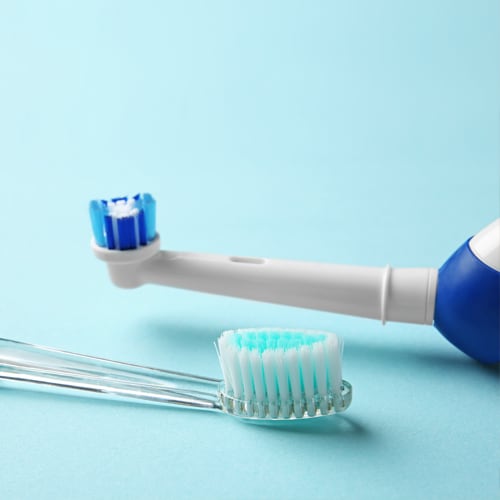Which is better, a manual toothbrush or an electric one?
This question may have already been put to you by your patients, but there is no black and white answer to this question. It depends. There is a huge array of different models of both manual and electric toothbrushes available on the market to choose from and every one of our patients is different, with their own individual oral health needs.
But what are the advantages and disadvantages of one type over another?
Manual toothbrushes might be more widely available in some areas and are certainly a more affordable option than their electric counterparts; especially when you consider the longer term costs of having to buy replacement heads for electric models. This might be a reason to initially consider manual brushes for children, especially in the younger age groups where toothbrush replacement might have to be more frequent as their dentition changes, as well as issues such as chewing on the brush which reduces the lifetime of the brush's bristles. Manual toothbrushes also do not rely on either batteries or being charged - and therefore never run out of power! This can make them a better portable option.
In terms of effective cleaning, it has been suggested that electric toothbrushes are more effective at removing dental plaque, but it can be argued that this is mostly down to an individual's technique rather than the type of brush. It could also be the result of a patient utilizing the wrong type of manual brush or failure to brush for long enough. Whichever type you recommend, with plenty to choose from, a brush can be recommended that suits a given patient. For example, if a manual brush is preferred and a patient has fixed orthodontic appliances the Colgate® Ortho Toothbrush has V-trimmed bristles designed to clean in and around these areas. Similarly, the Colgate® SlimSoft™ toothbrush has bristles that are thin enough to access beneath the gumline and a small, slim head for patients with hard to reach areas and tight contacts.
Electric toothbrushes can help with certain patient groups. Those with limited manual dexterity, for example patients with arthritis or other disabilities, might benefit from using electric toothbrushes which do the work for them, and the larger brush handles can help this group too. Conversely, in some patients the vibration and action of electric toothbrushes is not well tolerated, for example, patients with tremors caused by Parkinson's disease, or sensory issues in patients with autism. In these cases, a manual toothbrush may be preferable.
Some children will also be more suited to electric toothbrushes, which make effective brushing easier, help to clean around braces, and often have other features that are suited to children, for example, availability in different colors and designs, built-in timers, lights, tunes, games, etc. Alternatively, if a manual toothbrush will be recommended, one innovative option is the Colgate® Magik™ Augmented Reality Toothbrush & App. This lets children age 5 plus use a manual kids toothbrush with the advantage of a separate connector that acts as an app, tracks and gamifies brushing for them, and lets them collect rewards.
For electric toothbrushes, there has recently been wider availability of brush heads of different designs suited to an individual's needs such as interspace heads and soft bristles. One advantage of electric toothbrush heads is that they are often relatively small, especially compared to some manual toothbrush models, which helps get into the nooks and crannies around the mouth. Electric toothbrushes for adults also include versions that track brushing, provide immediate feedback and coach patients on how to brush better. One example is the hum brush which contains a smart sensor, provides guided brushing and allows the individual to collect rewards points.
Ultimately when recommending a type of toothbrush for your patients, you need to consider each patient's individual needs and desires to decide whether an electric or manual toothbrush is more suitable. You have also probably heard of the expression 'a bad workman blames his tools' and this applies to oral hygiene too! It's not just having the right brush for the job, it is knowing how to use it effectively; so whatever type of toothbrush you recommend for your patients, they will benefit from specific coaching on toothbrushing technique.


Was this article helpful?
If you’d like a response, Contact Us.